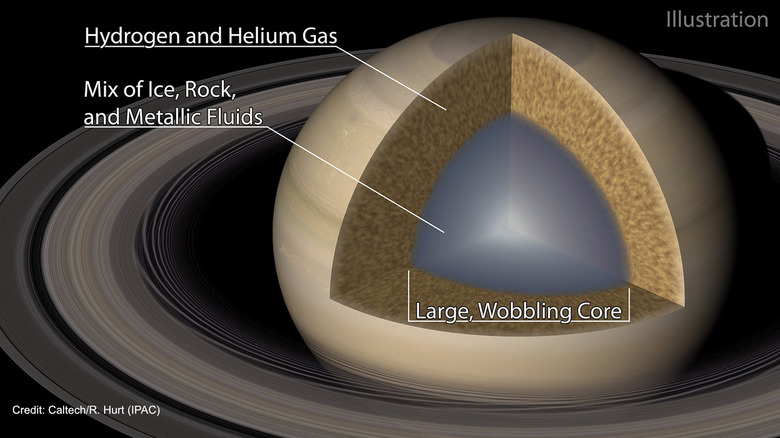Saturn's Full Of Soup: Cassini Torpedoes Gas Giant Theory From Beyond The Grave
Saturn's core is not the dense mass of rock that scientists once believed, but more likely a soupy sludge according to fresh analysis of data from the ill-fated Cassini spacecraft. Though NASA's probe may have met a crushing end as it plunged into the gas giant's atmosphere back in 2017, information about the way Saturn's rings wobble have unlocked unexpected details about what's deep inside.
Although Saturn may be a gas giant, the sheer extent of the forces involved near the center of the planet had led to theories that it would be rock. After all, with the pressures of gravity applied to materials there, the crushing forces were expected to have solidified the core.
However Cassini data doesn't necessarily support that assumption. While the spacecraft was destroyed far before it reached Saturn's core, analysis of readings of the planet's distinctive rings allowed astronomers at Caltech to come up with another theory. By examining the jiggling of those rings, they could extrapolate to what might be going on within Saturn itself.
"We used Saturn's rings like a giant seismograph to measure oscillations inside the planet," Jim Fuller, assistant professor of theoretical astrophysics at Caltech and co-author of the newly-published study, explains. "This is the first time we've been able to seismically probe the structure of a gas giant planet, and the results were pretty surprising."
Far from being a relatively small, dense core of rock, the heart of Saturn looks to be much larger than previously believed. In fact, it could extend across 60-percent of the diameter of the planet, and not be solid at all. Instead, it's "a diffuse soup of ice, rock, and metallic fluids" that's otherwise known as a "fuzzy" core.
That sludge is, unsurprisingly, no more welcoming an environment than rock might be. About 17 Earth-masses of the core is ice and rock, it's calculated, while the remaining 38 Earth-masses are fluid hydrogen and helium. It's not a unified mix, either, with the astronomers suggesting that different, stable layers have formed according to the weight of each.
It also chimes with other recent readings from our planetary neighbors, after NASA's Juno mission gave indications that Jupiter's core could be of the fuzzy variety, too. If that pans out, it could indicate that gas giants don't form in the generally accepted way.

That posited that a rocky core was first, and then gases accumulate around that, gravity building – and the size of the planet too – over time. However with a fuzzy core, gas accumulation would need to begin much sooner.
Using ripples in a planet's rings to calculate what might be happening inside isn't a new theory, with studies in the 1990s theorizing that it could be possible to track movement in the orbiting detritus and make inferences from that as to oscillations inside the planet itself. However it has taken Cassini's data to actually demonstrate the usability of that concept, partly because of how relatively small the motions actually are.
"Saturn is always quaking, but it's subtle," Christopher Mankovich, lead author of the study and a postdoctoral scholar research associate at Caltech. "The planet's surface moves about a meter every one to two hours like a slowly rippling lake. Like a seismograph, the rings pick up the gravity disturbances, and the ring particles start to wiggle around."
NASA is yet to announce a successor mission to Cassini, though the upcoming James Webb Space Telescope has observing the planet – and its moon, Titan – on its agenda.
